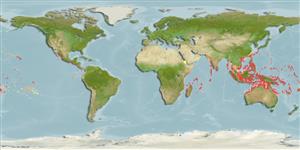Environment: milieu / climate zone / depth range / distribution range
Ökologie
seewasser riff-verbunden; tiefenbereich 20 - 40 m (Ref. 1602), usually 20 - ? m (Ref. 1602). Tropical; 30°N - 24°S
Indo-West Pacific.
Size / Gewicht / Alter
Maturity: Lm ? range ? - ? cm
Max length : 16.0 cm TL Männchen/unbestimmt; (Ref. 4421)
Rückenflossenstacheln (insgesamt) : 1 - 2; Rückenflossenweichstrahlen (insgesamt) : 30 - 33; Afterflossenstacheln: 0; Afterflossenweichstrahlen: 27 - 30. Blackish brown or bluish black head and anterior portion of body, rest of the body orange. A black blotch surrounding the gill opening. Caudal fin orange; soft dorsal and anal fins yellow; first dorsal spine blackish brown. Pelvic rudiment large not broadly attached to posterior margin of ventral flap. Scale ridge rugosities of male usually develop at about 65 mm SL. Scale spinulation on midbody not closely packed.
Inhabits clear coastal reefs and protected outer reef habitats with rich invertebrate growth (Ref. 48637). Prefers deeper reefs. Often in pairs (Ref. 9710). Sometimes solitary (Ref. 90102). Secretive, adults are usually in pairs (Ref. 48637).
Life cycle and mating behavior
Maturities | Fortpflanzung | Spawnings | Egg(s) | Fecundities | Larven
Hutchins, J.B., 1986. Review of the monacanthid fish genus Pervagor, with descriptions of two new species. Indo-Pac. Fish. (12):35 p. (Ref. 527)
IUCN Rote Liste Status (Ref. 130435)
Bedrohung für Menschen
Harmless
Nutzung durch Menschen
Fischereien: weniger kommerziell; Aquarium: Kommerziell
Tools
Zusatzinformationen
Download XML
Internet Quellen
Estimates based on models
Preferred temperature (Ref.
123201): 24.9 - 29, mean 27.8 °C (based on 316 cells).
Phylogenetic diversity index (Ref.
82804): PD
50 = 0.5039 [Uniqueness, from 0.5 = low to 2.0 = high].
Bayesian length-weight: a=0.01995 (0.00943 - 0.04220), b=2.93 (2.75 - 3.11), in cm total length, based on LWR estimates for this (Sub)family-body shape (Ref.
93245).
Trophic level (Ref.
69278): 2.9 ±0.4 se; based on size and trophs of closest relatives
Widerstandsfähigkeit (Ref.
120179): hoch, Verdopplung der Population dauert weniger als 15 Monate. (Preliminary K or Fecundity.).
Fishing Vulnerability (Ref.
59153): Low vulnerability (10 of 100).
Nutrients (Ref.
124155): Calcium = 68.7 [29.0, 170.0] mg/100g; Iron = 0.778 [0.357, 1.813] mg/100g; Protein = 17.9 [15.7, 20.1] %; Omega3 = 0.109 [0.051, 0.224] g/100g; Selenium = 30.6 [14.7, 70.2] μg/100g; VitaminA = 66.6 [18.2, 244.0] μg/100g; Zinc = 1.51 [0.98, 2.40] mg/100g (wet weight);
